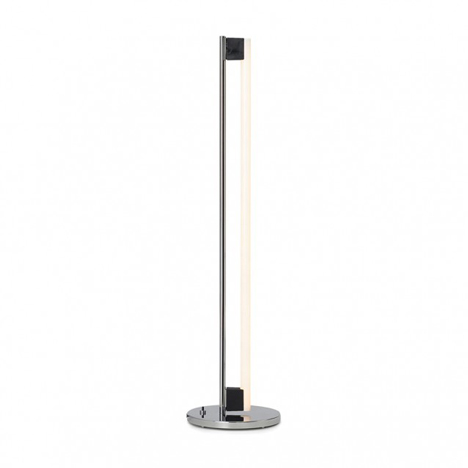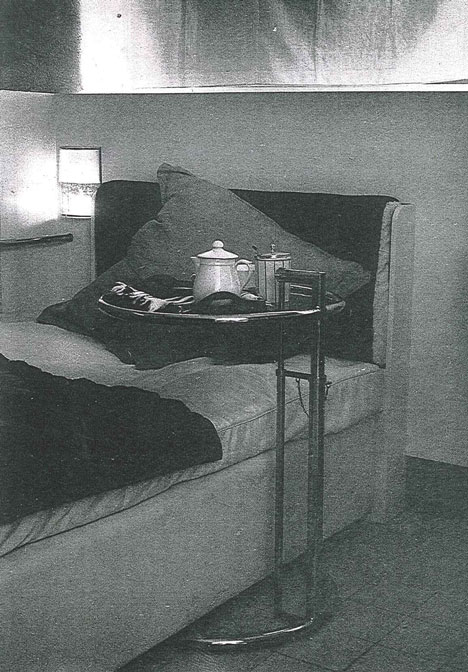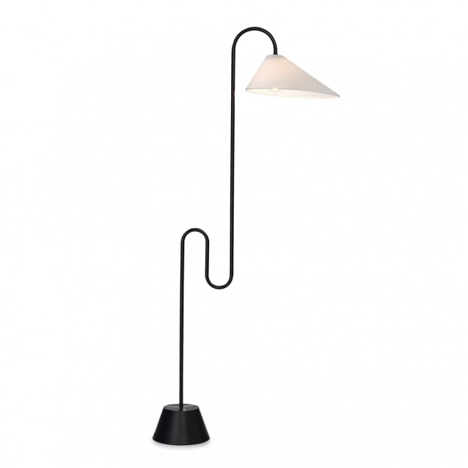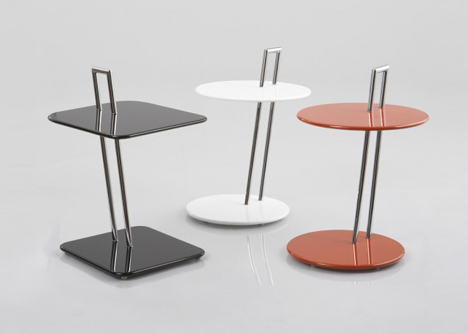Eileen Gray was "disappointed that she was forgotten" - Zeev Aram
Interview: forty years after he first met her, London design retailer Zeev Aram has launched a website dedicated to the work of his late friend, the modernist designer Eileen Gray. In this interview, Aram describes his working relationship with the elderly designer who, despite being frail and almost forgotten, could " see with one eye what many architects couldn't see with two eyes" (+ slideshow).

Zeev Aram is the owner of the Aram Store, which he launched in 1964 on London's fashionable Kings Road. He introduced the work of many legendary designers to the UK, including Marcel Breuer, Achille and Pier Giacomo Castiglioni, Le Corbusier and Eileen Gray, who he first met in 1973.
Aram says that Gray, who was revered in the 1920s and 30s for her modernist furniture and architectural projects, was almost forgotten by the time he first encountered her and was "a bit bemused that somebody was interested in her work."

Working with Gray, who was in her early-90s at the time, Aram began to reproduce some of her most famous pieces, including the Bibendum armchair, the E1027 table, and the Tube Light.
The two became close friends and Gray would regularly visit Aram at his showroom to talk about design. "Working with her was very, very appealing because she knew exactly her mind," recalls Aram. "With one eye she saw what many architects I know and admire couldn't see with two eyes."

A contemporary of Le Corbusier, Marcel Breuer and J.J.P. Oud, Gray was a pioneer of tubular steel and glass furniture and her architecture projects, including two houses in the Alpes Maritimes in southeast France, are now considered among the most outstanding examples of modernism from the interwar period.
Aram feels that Gray deserves to be considered alongside "all the other big shots, like Le Corbusier, Mies, Breuer," but because she chose a "quiet, modest life she was not included."
Before she died in 1976, Gray offered Aram the exclusive license to reproduce her products, but he now struggles to find the energy to battle the copyists who continually produce imitations. "I'm not prepared to spend my life with lawyers and solicitors and in courtrooms to prove that we have the license and these people are charlatans," he says.

The new website, www.eileengray.co.uk, features images and information about Gray's products and a timeline of her extraordinary life, which is currently being made into a feature film called The Price of Desire starring Orla Brady and musician Alanis Morissette.
We recently interviewed legendary German design Richard Sapper, who has launched a website documenting his career, while Richard Rogers spoke to us ahead of a retrospective exhibition of his work and claimed that architecture is losing sight of its civic responsibility – see more interviews.
Here's a full transcript of our interview with Zeev Aram:
Alyn Griffiths: When did you first meet Eileen Gray?
Zeev Aram: I met her in 1973. I think she was 92 or 93 and she was retired many years and living in her flat in Paris, but I actually met her here in London.

Alyn Griffiths: Did you meet with her to discuss licensing her products?
Zeev Aram: No, not at all. Actually, my knowledge of her was quite thin. I remembered reading about her many years earlier when I was in college and she was just part of the milieu of art deco artists and designers. I must admit I didn't really remember anything about her.
But then, in the late sixties there was a very interesting article written by Joseph Rykwert in Domus magazine about her and that triggered my curiosity about this particular artist that nobody wrote about, nobody talked about, nobody had seen her work. Neither had I, and then in the beginning of 1973 there was a small exhibition that my friend, the architect Alan Irvine, mounted at the Heinz Gallery that used to be the RIBA gallery in Portman Square and he said come along, it's a little exhibition but it's very interesting. So I went to see it but there were only pictures, and about three or four pieces of furniture and one of her rugs, so not very impressive and I looked at the pieces and the photographs and then I asked him how can I get in touch with her because I think her work is very interesting and very important but seems to somehow slip the consciousness of everybody, including me.

Alyn Griffiths: What did you think was so important about it?
Zeev Aram: Well, when you see something that triggers your curiosity and interest, that's a good enough reason to pursue it further. I didn't know what would come out of it, I didn't know if she would be at all interested in talking to me, but I did know that what I saw was good. I'd been around the design world for a while and introduced a few things to the country when we opened the store on the Kings Road in Chelsea, so I just wanted to see what's going to happen.

Alyn Griffiths: What was she like as a person?
Zeev Aram: Descriptive wise, she was a frail little lady. She was wearing glasses and one glass was black because she got injured in her eye and couldn't see in one eye. Very frail and very elegant, but not in an ostentatious kind of way. She was very shy but at the same time she knew exactly what's what.
She used to come over to visit her niece, the painter Prunella Clough, who would drive Eileen to us and we would sit and have tea and talk about little things, always more generally about what do I think about design and the way it is going and the way architecture is becoming very anonymous and nothing to do with the person who designed it.
It becomes a statement of structure, not a statement of the person who designed it. When she retired, she lived in the Roquebrune flat for many years and she was always doing little models and mock ups and plans, so she never retired from the work, as such, she retired from the world of the work. When she visited we would wander around the showroom and she would ask about the new materials and the new techniques like injection moulding and ABS plastics. She wanted to understand what was going on.

Alyn Griffiths: Did she ever talk about the past and her relationships with some of the great architects she has worked with?
Zeev Aram: Not really because actually, don't forget we're talking about a lady of 93. Her interest was never waning, but her energy was and her stamina was. So we constantly dealt with the work in hand, what we were doing. Whenever I raised something like that, she would say "that was a long time ago" and what that meant was, actually that's not interesting to talk about now.
She was very much involved and she knew her value, but you see – Joseph Rykwert said in his article that she was completely left in the sidelines, and everybody rushed ahead and the last person actually to pay homage to her was Le Corbusier because in the late thirties he included her work in an exhibition he did. And since then, until this article as Rykwert said, it's surprising that nobody has said, "Here's somebody that's really important". Meanwhile of course, we have all the other big shots, like Corbusier, Mies, Breuer etc, and she's not included.

Alyn Griffiths: Obviously you think she should be?
Zeev Aram: Not only that she should be. Not mega importance like Corbusier, who did the Unité d'Habitation, which is a very important statement architecturally. He knew how to major in publicity. But because of her modesty, maybe because of her style of life, she chose the quiet, the modest. If you are modest and you don't shout, nobody asks you to do anything. So that was what she was.
Working with her was very, very appealing because she knew exactly her mind. With one eye she saw what many architects I know and admire couldn't see with two eyes.
She was so precise, so accurate and so confident. For her to sit on a chair such as Bibendum and say to me it should be 3cm wider. I mean, I've worked with many architects – nobody would even – yes they'd measure, maybe it needs to be a bit wider, let me see. Anyway, she was quite an interesting person.

Alyn Griffiths: What was your working relationship like?
Zeev Aram: We were just working on the furniture because she was actually a bit incredulous. She wasn't taking it as a joke, but she was a bit bemused that somebody was interested in her work.
She wouldn't say it, although after several times meeting I managed to pull out a little bit because when we got to know each other she relaxed more and there was a bit of small talk and so on. I did sense that she was somewhat disappointed, but not in a sort of a big way – 'I'm a great person and nobody thinks of my name', but disappointed that she was forgotten. And yet, she knew – I mean J.J.P. Oud invited her to Holland and then they made a whole issue of her work and Rietveld said that she was one of the greatest and still the world just passed by. She was disappointed with a small 'd'. Without the content, that's the way life is, she had her wonderful years, she had wonderful fame, she had a wonderful working life – with ups and downs, and that's that.
By the time you become ninety and almost a recluse, you adopt to a certain view of the world and she wasn't expecting anything. So when Alan told her that this guy was interested to meet her and do something with her designs, she apparently shrugged her shoulders and said, 'Me? My work? Who'd be interested in my work?'

Alyn Griffiths: Which of her pieces is your favourite?
Zeev Aram: I love them all because they're like your children. Each one has got its own character, you like each one because of what it is and each one has got its own inherent function and beauty. So no, I have no favourites but I do like when I see three of the E1027 tables side by side. I think this is the most wonderful composition, just to see how one differs from the other and how she resolved the solution in the problem of the different tables, it's wonderful.
Alyn Griffiths: You worked with Eileen until her death in 1976 and in that time she decided that you were going to have the world license to produce her designs exclusively. Was that important to you?
Zeev Aram: Yes, very. It's very important, not because it makes me recognised and makes me important, it's important because I think we still haven't quite finished but we are getting there. When I decided that I would like to introduce the designs her name was not at all on the front line of anything design, worldwide I'm talking about, not the person. And I asked friends of mine, good friends, architects and designers to tell me about Eileen Gray. What do you know about Eileen Gray? Nine-and-a-half out of ten were sucking their teeth, saying the name reminds me of something but I can't put my finger on it. I'm paraphrasing, of course.
Now, 30 years have passed: it took Zeev Aram to make it happen – I'm sure that there would have been someone else but there wasn't, the fact is that we did it and now you are interviewing me not because she's an anonymous person, but because she's an important design person.

Alyn Griffiths: I wanted to ask you about having the exclusive license and how difficult it is to look after that and to make sure people aren't imitating these designs.
Zeev Aram: Yes, the table I mentioned before, the E1027, at last count there was something like 120 companies producing them. All over the place. You see, companies like Herman Miller and Vitra and Cassina are making big investments in these things and even so they cannot prevent people copying some of the designs. I think it is very frustrating, I have a whole pile of them, of people, and I just think we have won a few cases in the States and Germany and so forth. But life is too short. I'm not prepared to spend my life with lawyers and solicitors and in courtrooms to prove that we have the license and these people are charlatans. Because I tell you, there are police forces all over the world trying to prevent crime, and it still happens.
People who want the proper thing, they'll come to us. People recognise it, people are prepared to pay for it. Because people who understand quality that's the way it is. People who want the cheaper stuff, they buy the cheaper stuff and if it doesn't perform and it breaks down it's part of life. You buy cheap, you get cheap. And it’s not because I’m bitter about it, I'm not. It's a fact of life. After my last court case, which was some years ago in the States, I said never again will I go through anything against any company. Although we won the case in the federal court, all expenses paid etcetera, I am not prepared. It's too much. Too much of me going into that.

Alyn Griffiths: You've just launched a website dedicated to Eileen Gray's work. Why did you decide that now was the time to do that?
Zeev Aram: This is not a late show, not a late, late show. It's a damn late response. It was just one thing after another. We kept on saying it's nearly ready, its nearly there. Years of saying this! So you know what, Halleluiah that it's done. Now it's there and we'll make the best of it. It's still not quite right, it needs some adjustments done. But at least it's there for anyone who is interested in Eileen Gray and wants to know about her.
Alyn Griffiths: And what about the movie? Do you think that's going to help bring her to the attention of a wider audience?
Zeev Aram: I'm sure, because you know people do like to see a nice cinema movie and so forth. And don't forget the big retrospective exhibition at the Pompidou that will be opening very soon in Ireland, at the IMMA. Very nice. The same exhibition comes over to Ireland. And from then I think it's being negotiated to go over to the States and from there it probably goes to Tel Aviv.
So by putting her work in a more comprehensive way, not just little samples, on the world stage in these important venues, it's bound to enhance her reputation. And I mean there are quite a number of books written about her as you probably know and so it is all helping her reputation. She's not God, but if we talk about all these big names in the design world I think Eileen Gray should be one of them. You know, because she is that important as far as I'm concerned.

Alyn Griffiths: What is it about her work that is so unique and so special?
Zeev Aram: It's not that bend, its not that weld, its not that proportion, it's not that function – it's none of that. You must ask why do I think that the sunlight is wonderful, that the sunset is so wonderful. And you can't start enumerating them, listing them.
I really feel, and I'm not joking, I feel I have a blessed life that I'm able to walk between not only other designs which we have in the showroom, but to walk between Eileen Gray's work and to see all the time something fantastic and something interesting and something which gives me great delight. And it's not because it makes money you know, it's not the money value here.
It's the satisfaction to see the person who has been able to create such wonderful stuff and to anticipate what is going through our mind today, to anticipate this 50 or 60 years ago. And that's what makes it great.